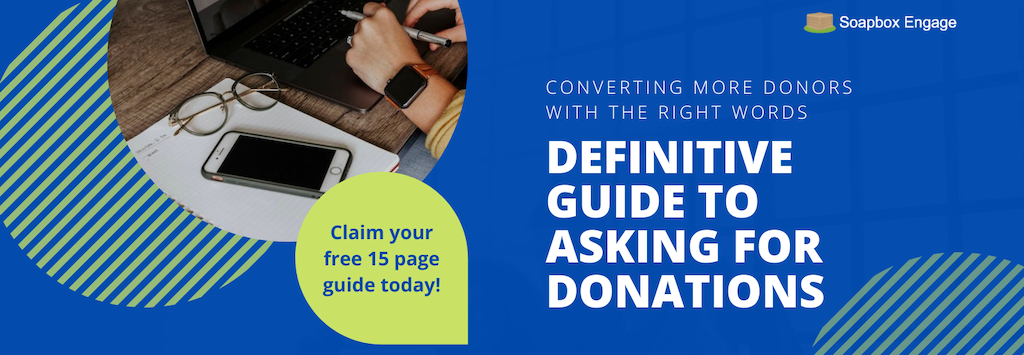
Technology may change, but mail will likely be with us forever. After all, there's no need to reinvent the wheel. In fact, direct mail appeal letters can develop your donor relationship in ways that social media falls short.
Printed appeal letters are tangible, empathetic, and powerful touchpoints with your supporters that inspire them to partner and give to your cause. Or at least that's what your appeal letters SHOULD be doing for you.
In this article, we're going to break down a few elements of what makes a great appeal letter, what moves donors to donate, and some tips on how to improve your letters. But if you're feeling writer's block, don't worry; we've got a few samples of fundraising letters to inspire you.
Table of Contents
3 Elements of An Effective Fundraising Appeal Letter
- Move your donors with empathy
- Connect donations to donors
- Use a donation deadline to create a sense of urgency
Fundraising Appeal Letter Tricks and Tips
What is a Fundraising Appeal Letter?
A fundraising appeal letter is typically a single-page document that details your nonprofit's needs, tells your donor how they can help, and thanks your supporter for their involvement. You can send appeal letters routinely throughout the year, as part of an annual push, a few months ahead of an event, or during a special campaign.
3 Elements of An Effective Fundraising Appeal Letter
While there are many ways to customize and style your appeal letter to match your organization's personality and brand, there are a few key components that make an appeal letter effective.
1) Move your donors with empathy
To connect with donors, it helps to go back to the fundraising basics. You want your donor to care about your cause, and in return, care about donating to your organization. Don't just talk about your organization's work. Your letter needs to be all about what your donor can do to solve a problem or injustice. You want to craft statements that allow your donor to be the hero, drive the change, and move the mark.
To do this, make sure you're using at least twice as many "you" words as "I" or "we" words. Consider these two contrasting examples. The first one focuses on the work of the organization by using "we" words. The second appeal letter makes the donor the hero simply by using more "you" words.
"We focused" example: At the Northern Virginia Foodbank, this year, we were able to bring steady meals to 253,000 Virginians who struggled with food insecurity through donations and volunteer efforts. As summer heads around the corner, children just like Dominic will struggle to have access to fresh, nutritious meals. We've set a goal of reaching 255,000 Virginians this year with enough food to feed them for the next three months. Will you join us in this drive? Your three-month recurring donation of $25 gives a family of four meals for …”
"You focused" example: Summer in Virginia means parks, picnics, and thanks to your support this year, fresh food, and veggies for Dominic. Dominic is one of the 253,000 Virginians whose family struggles with food insecurity. When school's out, Dominic doesn't have access to healthy regular school meals. But thanks to your regular support, you stand with us in making sure children like Dominic have access to a steady supply of nutritious meals. Your three-month recurring donation of $25 gives a family of four meals for …”
Here are some example sentences to pepper into your appeal letters:
- "You made this possible…"
- "You keep the mission going."
- "It's like you're here every morning..."
- "You can make the difference..."
- "Because of your support…"
2) Connect donations to donors
Donors want to see the impact of their donations, both as thanks for donating and as motivation to contribute in the future. When writing your appeal letter, focus on how recent donations have achieved mission goals. Also, share how future contributions will continue to spur on your efforts!
Successful nonprofits accomplish this by connecting facts and figures to stories. Of course, your donors want to see your organization's success. While numbers quantify your success, they alone aren't enough to inspire and motivate donors to keep giving. You need to tie those facts and numbers to an emotional response.
Here's a real example from The Women's Freedom Center Annual Appeal:
"Together with our donors, we have done some powerful work in our community this year. Their financial gifts made it possible to open a second shelter for women fleeing domestic violence and sexual assault; respond to over 1,700 crisis phone calls, provide hundreds of hours of support and advocacy, emergency financial and housing assistance, access to legal representation, transportation, and childcare to 638 women, 17 men, and 478 children who have been abused. At this year's current pace, we expect those numbers to double.
"Sometimes it's hard to remember that each of the numbers counted is a person in our community; one of us in need of support, resources, or understanding as she taps into her own resilience, strength, and creativity. One woman with whom we worked recently stopped by to give us a thank you letter and gift. She invited us to share with you why she donated…"
This nonprofit found a way to remind its donors that every number is a person and a story. This is a valuable fundraising strategy that you should be using throughout your fundraising efforts, but especially in your appeal letters.
3) Use a donation deadline to create a sense of urgency
After reading your heartwarming story about how their donation will change lives and save the world, you don't want to leave your donors thinking, "Maybe I'll donate later." Capitalize on the emotional pull of your letter with a donation deadline. Ask your reader to give ASAP or before a specific date.
For example, suppose you're sending a letter out in mid-August. In that case, you might write: Our students are preparing to return to school, but they're underprepared to succeed. Without access to textbooks and school supplies, they're starting school without the basic necessities. With your $10 donation, you can give students like Rachel and Donte the opportunity to reach their dreams. But, you need to act now!
Fundraising Appeal Letter Tricks & Tips
Now that you've got all the ingredients of an effective fundraising letter, here are a few tips and tricks from industry experts to help you get the most out of every appeal letter campaign.
Add a postscript
Have you ever opened a book and flipped to the last page, or opened a letter from someone you didn't know and skipped right to the end? Studies show that when your donor opens their letter, they're likely to go straight to the bottom of your letter to get straight to the point of what you're trying to say.
Here are some tips to make your postscript memorable:
- Put your postscript in bold and use a different font color from the rest of the letter to help it stand out.
- Keep your postscript short, no longer than 2-3 sentences and no more than 4 lines of text.
- Restate your ask succinctly but emotionally: “Please donate to help a child read.”
- Remind your readers about the deadline: “Donate before December 1st!”
- Ask for a donation to do something: “$20 puts a textbook in a child's hands.”
Segment your donation suggestions by audience
2019 and 2020 saw explosions of giving in both the low and mid-tier gift amounts, and a moderate increase in high-tier gifts, too. And, as you already know, not all of your donors can afford to give the same amount. So why send the same letter to each supporter?
Using your Salesforce Database (or any effective CRM system), you can create mailing lists based on recent donation amounts. From there, look at those donations and create different letters that subtly suggest higher amounts for each of your target audiences. The main body of the letter can even be exactly the same.
Example: If your letter's audience usually donates somewhere between $15-$20, suggest tiered donation amounts of $20, $25, $50, and $100.
If your letter's audience usually donates $100, suggest a recurring gift of $50 or a one-time donation of $100, $125, $150, or $200.
Most industry experts also agree that customizing the appeal to each giving tier improves overall fundraising. Studies also show that recent active donors are the ones most likely to respond to your appeal letter. That means timing and efficiency are everything!
If you're still hand-entering donor information into your database, now would be the time to consider investing in a good CRM system for your nonprofit, like Salesforce and Soapbox Engage. Each of our apps directly communicates with Salesforce, meaning every action is immediately entered into the database for you.
Streamlining your reporting and donor management process helps you respond more quickly to your donors and empowers you to "strike while the iron's hot," as they say.
Now that you're ready to send high quality, effective fundraising appeal letters, here are three more resources to help you get the most out of your fundraising efforts.
- The Online Fundraising Software Buyer's Guide: are you thinking of upgrading your fundraising software? If you took a peek on the internet, you probably realized the options are overwhelming. This blog offers an easy, three-step process to identify the best online fundraising tools, software, and platforms to help you organize and streamline your fundraising efforts.
- 8 Proven Ways to Grow Your Nonprofit Email List: Email updates are another proven method of reaching a broad audience. They're great for staying in touch with donors throughout the year. Conveniently, email also has one of the highest returns on investment of all the online marketing options for businesses and nonprofits. This blog will help you grow your email list so you can reach more potential donors and stay in touch with your current supporters!
- The Nonprofit Marketing Guide for Busy Fundraisers: Does your nonprofit have a marketing plan? You should. And, it should work cohesively with your donor relationships, fundraising, and organizational goals so you can increase donations and improve your visibility and presence in your community. This blog will help you develop an easy, efficient marketing strategy for your nonprofit!

